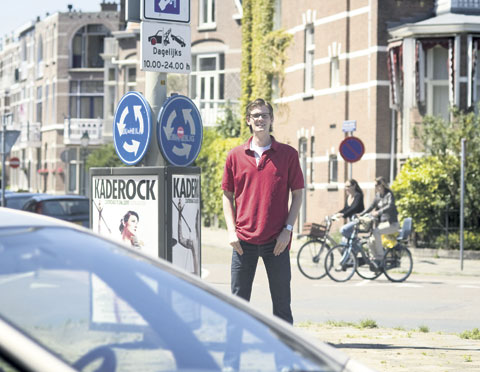Waiting for red traffic lights is not Bob Granneman’s favourite pastime. For his Master’s thesis he investigated turbo roundabouts.
Those terrible traffic lights that always keep you stuck at intersections, who hasn’t cursed them? Luckily, traditional junctions are increasingly being replaced by roundabouts, thus ridding the country of stoplights.
If it’s up to Bob Granneman however, future roundabouts – more specifically turbo roundabouts – will also be equipped with lights. This will not only increase safety but – and this may come as a surprise – also speed things up for everyone.
Turbo roundabouts are a new type of circular junctions that force motorists to choose their direction before entering the junction, thereby eliminating many conflicting paths and choices on the roundabout itself. They are a relatively new invention by Granneman’s daily supervisor, Bertus Fortuijn, who worked for the province South Holland. Over a hundred turbo roundabouts have been built thus far in the Netherlands, mainly at places where a major road crosses a road with less traffic.
Last month at the faculty of Civil Engineering & Geosciences, Granneman defended his Master’s thesis about the effect traffic lights have on regulating the flow to turbo roundabouts.
At locations where a two-lane roundabout got a turbo upgrade, traffic capacity increased from 3000 to 3500 vehicles per hour, according to the young engineer.
“But since this type of roundabout is so new, the limitations are not well known yet,” Granneman adds. One of the problems that may arise is that the waiting time for motorists on the roads with less traffic becomes too long when traffic increases on the major road.
Granneman modeled what would happen if traffic was regulated by a two-coloured traffic light situated on the main road stream, with the aim of this signal being to cluster the main traffic stream and thus obtain more acceptable gaps for the minor traffic stream.
“You’d expect the waiting time to be distributed more evenly with this device, at the expense of the main stream,” says the engineer. “But what I’ve found to my surprise is that the main stream also benefits. At a certain moment they also start to profit from the gaps. When more than 1400 vehicles pass the roundabout per hour on the main stream, the waiting time for motorists on the main stream decreases from one minute to half a minute.”
“The simulations show that metering is an effective solution to keep performance up to standards,” Granneman concludes. “No large-scale modifications will be necessary in the near future.” Just more traffic lights.
Die opvatting slingerde D66-Kamerlid Boris van der Ham vandaag de zaal in tijdens het Politieke Lunch-debat van de OWEE. Hij deed dat bij het voorstellen van de deelnemers.
Van der Ham was al geïntroduceerd als ex-acteur die de overstap had gemaakt naar de politiek. Bij het voorstellen van SP’er Jasper van Dijk vertelde gespreksleider Lars Duursma dat Van Dijk al op heel jonge leeftijd met vriendjes debatten tussen CDA’er Van Agt, VVD’er Wiegel en PvdA’er Den Uyl naspeelde.
Het leek Duursma leuk als Van Dijk met Van der Ham de zaal zou tonen hoe dat moet zijn gegaan. Voor Van der Ham moest dat met zijn verleden als ex-acteur geen probleem zijn.
Op de vraag van Duursma of hij dan Van Agt of Wiegel wilde zijn, was Van der Ham resoluut. Hij wilde absoluut niet Wiegel zijn. “Die was de slechtste minister van Binnenlandse Zaken.” Van het naspelen kwam het – op een intro met zachte g door Van der Ham na – verder overigens niet.



Comments are closed.